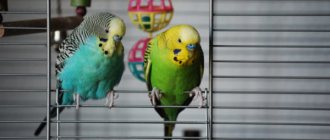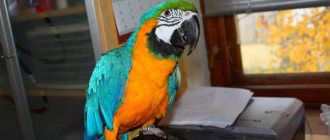Lovebirds are small, colorful parrots from Africa. They got their name from monogamy - they choose one partner for life, and have a hard time if they lose him. Although these birds are kept alone, it is better to buy a pair. Together, the birds will not get bored and will be more willing to communicate with humans. In order for your pets to live a long and happy life, and in captivity this is 15–20 years, provide them with good conditions.
Description of the species
There are 13 varieties of ringed parrots, each of which has its own distinctive characteristics: for example, a pink breast in the rose-breasted parrot, a red head in the plum-headed parrot, and a stripe on the bridge of the nose in the Kramer parrot. What everyone has in common is a necklace around their neck. At the front there is a black “collar” that closes at the back of the head in the form of a necklace of a contrasting color - pink, blue or light green. Females and young males do not have this stripe.
The bird has a slender, fit body of medium size: size 40 - 45 cm, half of which is a thin, pointed tail. The wings, back and belly are covered with green feathers of different shades with clear transitions. The feathers fit tightly to each other and do not puff up anywhere, resulting in a very neat, neat appearance.
Another feature of the necklace parrot is its rounded beak, wide at the base and sharp at the tip. The mandible is colored red or orange, the mandible is brown, it is significantly smaller than the upper part. The tail is cascading, the longest feathers grow in the center, their shade is turquoise.
Purchase rules
It is customary to take parrots home when they are very young, so that it is easier for them to get used to their new owner. After the first two months of life, the chick does not need parental care, it becomes independent, and it is at this time that you should buy it. At this age, the bird has a small size, an orange beak, and no necklace, so the likelihood of error is minimal.
- The parrot should be well-fed, with a rounded sternum, smooth plumage;
- A healthy bird is active and curious, a sick bird is apathetic, disheveled, and drowsy;
- A lot of feathers in the cage, undertails stained with droppings are signs of a serious illness. This is not worth buying.
It is recommended to take a ringed parrot for home keeping from a specialized nursery or purchase it from a reputable breeder. Buying from an advertisement or at the poultry market is very risky, as you can buy an individual of the wrong breed, with developmental or behavioral defects.
Keeping at home
Owners usually speak positively about pet ring-necked parrots. These birds are unpretentious, treat people well, and have an even character. In order for the behavior of the bird to be a joy for the owner, it is necessary to provide the pet with care and acceptable conditions: comfortable housing, the right microclimate, a balanced diet. A spacious cage for a tame parrot is the first condition for decent maintenance.
Cell
A cage for keeping a pet must meet several requirements:
- safe material;
- strong rods;
- reliable lock;
- bottom protection made of plexiglass;
- pull-out tray
The last condition is of particular importance for ease of care: necklace parrots are quite clean. They will not sink to the dirty bottom. The optimal cage size is 80 / 60 / 150 cm. The shape is not important - birds will normally accept both a rectangular and rounded cage, as well as a design with a domed top. The contents are standard: feeders, drinking bowls, toys, perches. All equipment must be of high quality and safe.
Microclimate
Ornamental birds should be kept in comfortable conditions. The necklace parrot adapts well to cool weather, but still prefers warmth. Although its plumage is quite dense, it is not designed for low temperatures. Before buying, you should think about proper care, prepare a secluded corner where there will be no drafts and dry heat. This means away from windows and radiators.
Air with low humidity has a bad effect on plumage and mucous membranes. Excessive humidity does not have the best effect on health: fungus, mites, and other parasites grow on the skin. Thus, normal air humidity when keeping a parrot in an apartment is approximately 60%. In this case, the temperature must be maintained at 18 - 25 degrees. In the evenings, artificial lighting irritates necklace parrots, so you can throw fabric over part of the cage.
Free range
The ringed parrot needs space. Constantly being kept inside a cage, even with impeccable care, makes the bird sad. In order for the bird to feel great, it needs to fly out of the cage every day and explore the rooms. During walks, one of the family members must watch the pet, otherwise it will damage the furniture and may harm itself. Before opening the door, carefully look around: remove dangerous objects, close windows, remove poisonous plants. This will make subsequent cleaning easier for you and protect your parrot.
Where to place
Often, when choosing a place for a parrot, preference is given to the most accessible room: the kitchen or living room. And this is right, because this way the pet will be able to see people more often and get bored less. However, the lovebird cage should be located away from an electric or gas stove or heating radiators. It should not be placed on a window - direct sunlight in summer and cold air currents in winter are harmful to parrots.
It is better to place the cage on a shelf or cabinet near the wall, so that no one can approach the parrot from one or both sides - a kind of shelter. A comfortable height is considered to be 1.5 meters above the floor. Then the lovebird will have a good overview, and the owner will be able to conveniently pour food and change water, do cleaning and communicate with the pet.
Care and feeding
Domestic parrots are completely dependent on people, this is obvious in the matter of nutrition. In nature, birds independently choose what food they will peck at the moment. Tame pets destined to be kept in an apartment can only count on the generosity of the owner. A caring owner who understands bird care knows how to please a parrot: a kind word, a tasty treat, a new toy. When the physical needs of the bird are satisfied, it is necessary to satisfy the intellectual hunger - necklace parrots learn well and gain a small vocabulary.
How to teach to speak
Full training for necklace parrots is impossible, since these birds have insignificant talents. A pet that is tamed in a timely manner is very trusting; with good care, it becomes attached to the owner and tries to copy his speech. It cannot be said that the ringed parrot is talkative, but it is able to remember one or two dozen words.
Conditions for successful speech imitation:
- young age;
- single content;
- regularity of lessons;
- calm tone of the “teacher”;
- encouragement for interest in classes.
What to feed
Keeping and caring for a necklace parrot does not require any special nutrition. Everything is the same as for other medium-sized ornamental birds: dry grain mixture with a predominance of millet, juicy fruits and vegetables, herbs, mineral supplements. Ringed animals love nuts and crack them with pleasure. Properly feeding a tame parrot - what does it mean?
- give 30 g of grains daily;
- every other day, put chopped raw vegetables or fruits in the feeder;
- supply your pet with fresh grass and branches;
- use a mineral mixture, stone or sepia.
If grain in original packaging is chosen as the main feed, additional vitamin complexes are usually not required. The necklace parrot should be fed with supplements during particularly important periods of its life: during molting, breeding, or during illness.
How to clean a cage
Home maintenance of a necklace parrot includes regular cleaning of the cage, disinfection, and timely replacement of equipment. Cleaning the cage and caring for accessories is time-consuming, but necessary. In good sanitary conditions, the bird gets sick less, has an excellent appetite, and a desire to communicate.
Cleaning can be scheduled while the parrot is walking. Opening the door and waiting for the bird to leave the home, take out the feeders and drinking bowl and soak them in soapy water. Wipe the rods and perches with a damp cloth, then pull out the tray and empty it of debris. Rinse the grill under running water, wipe it and return it to its place. Lay paper towels on the bottom. Place containers for food and water inside.
Diseases and prevention
Ringed parrots are usually resistant to infectious diseases. Their main problem is hypovitaminosis and mineral deficiency. Due to an unbalanced diet, the bird develops symptoms of rickets, it pulls out feathers and becomes lethargic.
When intoxicated they experience:
- dyspnea;
- decreased immunity;
- diarrhea;
- vomit;
- refusal to eat;
- decreased physical activity.
All About Pets: Ruffed Parakeet
A weakened bird can easily become ill with a bacterial infection or parasitic infestation. In the latter case, feather and ixodid mites, worms, and blood-sucking flies are found in Kramer's birds.
To prevent the development of any disease, it is necessary to remove potentially dangerous objects from the room with the parrot and provide the pet with constant care. It is necessary to keep the bird’s home clean, wash the feeder and drinker daily, refresh the food and balance the diet.
Appearance of a necklace parrot
Necklace parrots are not as brightly colored as some members of their order. The main color of the feathers is light green or yellow green . Bluish plumage is visible on the back of the head and wings.
A narrow strip of dark color descends from the eyes to the beak. Parrots got their name due to the presence of a stripe on their necks, similar to a necklace or tie.
This type of parrot has pointed feathers and a long stepped tail. weighs approximately 150 grams . The wing length is 16 centimeters.
In size, necklace parrots can reach up to 50 centimeters . Their legs are weak. When moving on the ground, parrots use a strong beak as additional support. Females and males differ in the color of their plumage.
Females do not “wear” a necklace around their neck.
A distinctive feature of young parrots is their red-orange beak. Three to four weeks after the chick leaves the nest, an orange ring appears around the eyes.
After a certain time, the beak becomes red and the mandible acquires a black tint. Adult plumage and coloring in males appears after the second year of life.
The average lifespan of this type of parrot is up to 30 years , provided they are well cared for.
Origin of the Necklace Parakeet
This species of parrot is the only one whose habitat is in two parts of the world - Asia and Africa.
You can also find a similar bird in Australia, in Madagascar, where they are slowly but surely evicting local aboriginal birds. These birds were once inhabitants of the Rodrigues and Reunion islands, but have since disappeared from these places.
Mauritian necklace parrots are also in danger of becoming extinct. Parrots live not only in forests, but can also choose a place not far from human settlements as a permanent habitat.
Habitat and living conditions
The habitat of the necklace parrot covers the regions of South Asia and East Africa. The birds were artificially brought to Madagascar and Indochina and sold in Australia and Egypt. In the Republic of Mauritius, necklace parrots are endangered. The population on Rodrigues Island is considered extinct. At the same time, some species have adapted to the cold climate in Germany and Belgium.
Habitat of the parrot
Kramer's birds rest and build nests in dense forests. Tall trees make their eggs difficult to reach for predators. Ringed parrots try to settle closer to populated areas. They can travel up to 800 km a day in search of food, but proximity to humans makes it easier to find food.
Keeping a necklace parrot
This type of parrot was tamed by humans in ancient times. The bird is inherently smart and unpretentious. Very quickly becoming attached to its owner, it becomes completely tame.
Some parrots can be taught to speak.
With the right approach, a bird can reproduce about 60 different words . Your parrot will be able to talk when it reaches one year of age.
You can wean off sharp, piercing screams. A parrot can also be trained to perform certain actions. It is worth taking into account that if you want to achieve results, you need to start training the bird as early as possible, from the age of the chick.
Around the age of three, birds become more distrustful and less capable.
Optimal climate for the necklace parrot:
The necklace parrot tolerates temperatures down to zero degrees Celsius. However, the most optimal conditions for their maintenance are considered:
- temperature does not drop below 15°C,
- at air humidity 60 - 70%.
- A parrot's daylight hours should not last more than half a day.
Character
Parrots have a soft and good-natured character. The bird is highly physically active and quickly gets used to life in captivity next to humans. The pet does not cause problems for the owner and does not show aggression. A ringed parrot can be weaned from loud cries.
The behavior of birds older than 3 years differs depending on their gender. If you bring a mirror to the male, he will open his beak and spread his wings. The eyes narrow.
Personality of the Necklace Parrot
Diet of the necklace parrot
Particular attention should be paid to the parrot's nutrition so as not to spoil its delicate stomach and not disrupt its natural metabolism. Otherwise, the parrot may become seriously ill.
The main food is a mixture of grains:
- canary seed 10%,
- millet 40%,
- sunflower 10%,
- oats or oatmeal 20%,
- wheat 20%).
They need to be mixed only in certain proportions. The norm is considered to be about 30 grams of mixture per day.
Don't forget about mineral supplements. They must be present in the parrot's diet. Also, the pet will not refuse:
- sprouted wheat,
- nuts,
- ripe corn.
About once a week you need to add soft food to your parrot's menu
House care
The cage must be looked after every day. A typical procedure includes cleaning the tray, drinking bowl, feeder, perches and toys. General cleaning is required every 10 days . In addition to cleaning accessories with water, they should be treated with a disinfectant solution/spray.
You can buy such products at almost any pharmacy. The main thing is that the drug does not have a prolonged effect, otherwise the active substances will enter the parrot’s gastrointestinal tract and cause serious poisoning. During general cleaning, the cage itself must also be thoroughly washed and treated with a disinfectant.
Reproduction of the necklace parrot
For the most part, parrots are monogamous. Having chosen a mate, they remain with her throughout their lives. Both “spouses” mutually take part in breeding and feeding their offspring.
When choosing a mate for your pet, keep in mind that young, old and sick, sedentary parrots lay “empty” eggs, from which you are unlikely to get chicks.
After the nest is established, in a period of time equal to 2 - 3 weeks, the female lays eggs and sits on them. Hatching time is about three weeks.
Most of the time, the hen and then the young mother and her brood are fed by the male. More precisely, he gets food, and the mother herself gives it to the babies. Only after they have grown up a little is the father of the chicks allowed to take part in this important task.
Necklace parrots hatch a clutch of three to five white eggs. However, this does not mean at all that you will have just such an offspring.
Some embryos die right in the eggs, some die after hatching. They breed twice a year.
Waking and sleeping
Kakariki are not only mobile and living pets. They must be in a state of full sleep for 12 hours a day. Sometimes the summer time period allows you to reduce this time by 1 hour, and the winter time period allows you to increase it.
In connection with this need, regulation of daylight hours is carried out by using special lamps that will extend daylight hours at night.
Lack of sleep affects birds negatively. The next day, if you don't get enough sleep, your pet will be irritated.
To send the kakarik to sleep at night you will need an opaque cloth. A thick dark blanket or a special cage cover is suitable for this.
View this post on Instagram
Publication from











